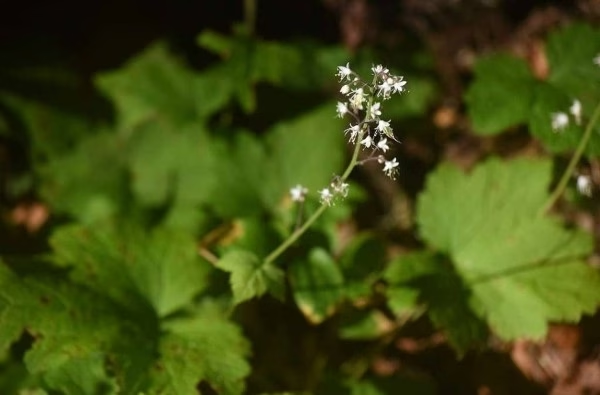
Foamflower
Botanical Name
:
Tiarella spp.
Plant Type
:
Herbaceous perennial
Seasons
:
Plant in spring or fall; blooms in spring
Sun Level
:
Partial to full shade (depending on the species and climate); prefers shade in hotter climates
Ideal Soil Temperature for Planting
:
40–65°F (4–18°C)
Soil Type
:
Moist, well-drained, humus-rich soil
Hardiness Zones
:
3–9 (USDA)
Germination
:
Can be slow and uneven from seed. Division is more common
P.H. Level
:
5.5–6.5 (slightly acidic)
Water/Irrigation
:
Keep soil consistently moist, especially during dry periods. Avoid soggy soil
Fertilization
:
Apply a balanced fertilizer in spring as new growth begins
Habit
:
Clumping, spreading (by rhizomes in some species)
Propagation
:
Division (in spring or fall), sometimes by seed
Final Plant Height
:
6–12 inches
Spread
:
12–18 inches
Flowers
:
Small, delicate, white or pink flowers borne on slender stalks. The foamy appearance comes from the many stamens
Attracts
:
Bees, small butterflies
Uses
:
Ground cover, shade gardens, woodland gardens, container plantings
Companions
:
Hostas, ferns, astilbe, bleeding heart (Dicentra), lungwort (Pulmonaria)
Pruning
:
Remove faded flower stalks after blooming. Cut back any dead or damaged foliage in late winter or early spring
Toxicity
:
Generally considered non-toxic to humans and animals
Pests
:
Slugs, snails, aphids
Diseases
:
Powdery mildew, root rot (in poorly drained soil)
Confused With
:
Other woodland plants with similar flowers, such as Heuchera (coral bells) and Mitchella (partridgeberry)
Additional Info
:
Native to North America. The name “Tiarella” comes from the Greek word “tiara,” referring to the shape of the seed capsules
Botanical Name
:
Tiarella spp.
Plant Type
:
Herbaceous perennial
Seasons
:
Plant in spring or fall; blooms in spring
Sun Level
:
Partial to full shade (depending on the species and climate); prefers shade in hotter climates
Ideal Soil Temperature for Planting
:
40–65°F (4–18°C)
Soil Type
:
Moist, well-drained, humus-rich soil
Hardiness Zones
:
3–9 (USDA)
Germination
:
Can be slow and uneven from seed. Division is more common
P.H. Level
:
5.5–6.5 (slightly acidic)
Water/Irrigation
:
Keep soil consistently moist, especially during dry periods. Avoid soggy soil
Fertilization
:
Apply a balanced fertilizer in spring as new growth begins
Habit
:
Clumping, spreading (by rhizomes in some species)
Propagation
:
Division (in spring or fall), sometimes by seed
Final Plant Height
:
6–12 inches
Spread
:
12–18 inches
Flowers
:
Small, delicate, white or pink flowers borne on slender stalks. The foamy appearance comes from the many stamens
Attracts
:
Bees, small butterflies
Uses
:
Ground cover, shade gardens, woodland gardens, container plantings
Companions
:
Hostas, ferns, astilbe, bleeding heart (Dicentra), lungwort (Pulmonaria)
Pruning
:
Remove faded flower stalks after blooming. Cut back any dead or damaged foliage in late winter or early spring
Toxicity
:
Generally considered non-toxic to humans and animals
Pests
:
Slugs, snails, aphids
Diseases
:
Powdery mildew, root rot (in poorly drained soil)
Confused With
:
Other woodland plants with similar flowers, such as Heuchera (coral bells) and Mitchella (partridgeberry)
Additional Info
:
Native to North America. The name “Tiarella” comes from the Greek word “tiara,” referring to the shape of the seed capsules
Written by Nondiah Khalayi – https://www.linkedin.com/in/nondiah-khalayi/

